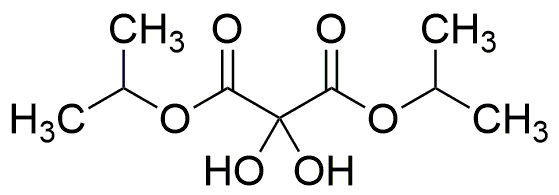Diisopropyl 2,2-dihydroxymalonate is widely utilized in research focused on:
- Pharmaceutical Development: This compound serves as a key intermediate in the synthesis of various pharmaceuticals, enhancing the efficiency of drug formulation processes.
- Polymer Chemistry: It is used in the production of specialty polymers, providing improved thermal stability and mechanical properties compared to traditional monomers.
- Agricultural Chemicals: The compound plays a role in developing agrochemicals, particularly in creating more effective herbicides and pesticides that are less harmful to the environment.
- Cosmetic Formulations: Its moisturizing properties make it a valuable ingredient in skincare products, helping to improve skin hydration and texture.
- Food Industry: It is also explored as a food additive, where it can enhance flavor profiles and act as a preservative, ensuring longer shelf life for products.
General Information
Properties
Safety and Regulations
Applications
Diisopropyl 2,2-dihydroxymalonate is widely utilized in research focused on:
- Pharmaceutical Development: This compound serves as a key intermediate in the synthesis of various pharmaceuticals, enhancing the efficiency of drug formulation processes.
- Polymer Chemistry: It is used in the production of specialty polymers, providing improved thermal stability and mechanical properties compared to traditional monomers.
- Agricultural Chemicals: The compound plays a role in developing agrochemicals, particularly in creating more effective herbicides and pesticides that are less harmful to the environment.
- Cosmetic Formulations: Its moisturizing properties make it a valuable ingredient in skincare products, helping to improve skin hydration and texture.
- Food Industry: It is also explored as a food additive, where it can enhance flavor profiles and act as a preservative, ensuring longer shelf life for products.
Documents
Safety Data Sheets (SDS)
The SDS provides comprehensive safety information on handling, storage, and disposal of the product.
Product Specification (PS)
The PS provides a comprehensive breakdown of the product’s properties, including chemical composition, physical state, purity, and storage requirements. It also details acceptable quality ranges and the product's intended applications.
Certificates of Analysis (COA)
Search for Certificates of Analysis (COA) by entering the products Lot Number. Lot and Batch Numbers can be found on a product’s label following the words ‘Lot’ or ‘Batch’.
Numéro de catalogue
Numéro de lot/série
Certificates Of Origin (COO)
This COO confirms the country where the product was manufactured, and also details the materials and components used in it and whether it is derived from natural, synthetic, or other specific sources. This certificate may be required for customs, trade, and regulatory compliance.
Numéro de catalogue
Numéro de lot/série
Safety Data Sheets (SDS)
The SDS provides comprehensive safety information on handling, storage, and disposal of the product.
DownloadProduct Specification (PS)
The PS provides a comprehensive breakdown of the product’s properties, including chemical composition, physical state, purity, and storage requirements. It also details acceptable quality ranges and the product's intended applications.
DownloadCertificates of Analysis (COA)
Search for Certificates of Analysis (COA) by entering the products Lot Number. Lot and Batch Numbers can be found on a product’s label following the words ‘Lot’ or ‘Batch’.
Numéro de catalogue
Numéro de lot/série
Certificates Of Origin (COO)
This COO confirms the country where the product was manufactured, and also details the materials and components used in it and whether it is derived from natural, synthetic, or other specific sources. This certificate may be required for customs, trade, and regulatory compliance.

